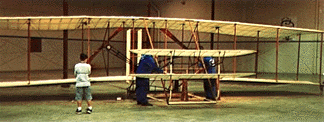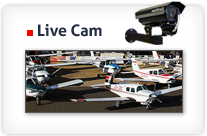Engineering
1903 WRIGHT FLYER STATISTICS
This full scale replica with its wing span of 40 feet 4 inches is probably the most exact replica ever built, as it was built not just for display or even to fly, but to be the source of precise aerodynamic data. Many unique encounters along the way have assisted us in achieving this.
Exterior Dimensions:
| Wing Span | 40 ft. 4 in. |
| Overall Length | 21 ft. 1 in. |
| Wing Chord | 6 ft. 6 in. |
| Height over Wings | 8 ft. 1 in. |
| Height over sweep of props | 9 ft. 4 in. |
| Wing Incidence | 3 degrees 25 minutes |
Surface Areas:
| Wing Area | 518 sq. ft. |
| Canard Area | 48 sq. ft. |
| Rudder Area | 20 sq. ft. |
Weights:
| Weight Without Pilot | 605 lbs. |
| Loaded Weight | 750 lbs. approx. |
| Engine Weight w/Fuel | 200 lbs. approx. |
| Powerplant | 12 BHP 4-cylinder water-cooled engine lying on its side and driving 2 – 8 ft. 6 in. diameter propellers by chains, one of which was crossed to achieve counter-rotation. |
Loadings:
| Wing Loading | 1.47 lb./sq. ft. |
| Engine Loading | 62.5 lb./hp. |
Flight Characteristics:
| Speed | 30 mph approx. |
| Launching Method | The Flyer took off under its own power from a dolly which ran on two bicycle hubs along a 60 ft. wooden rail. |
First airplanes to Fly:
| USA | Dec. 1903 | Austria | April 1908 | |
| France | Nov. 1906 | Russia | July 1908 | |
| Italy | 1907 | Sweden | July 1908 | |
| Germany | June 1907 | Romania | Oct. 1908 | |
| Gr. Britain | Oct. 1908 | Canada | Feb. 1909 |





